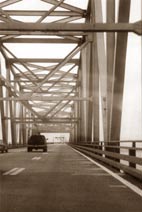 |
|
futurama, autogeddon |
|
Imagining the Superhighway From Bel Geddes to Ballard |
eight: simulations and ghosts
[21] Ballard's collapsing of space and time comes to the forefront in Crash (1973). In the surreal landscape of the highways surrounting Shepperton (an airport suburb surrounded by London's answer to the Beltway system), he taps into the ultimate fear of every commuter: the "end of the world by automobile" (50). Space and time, in Crash, are determined by the intimate interior of the smashed-up automobile, "fossilized for ever in this web of chromium knives and frosted glass" (12). On the highways, time stops: Looking around, I had the impression that all the cars on the highway were stationary, the spinning earth racing beneath them to create an illusion of movement (196).
It obliges us more than ever to think the virtualization of space and time, the possibility of virtual events whose movement and speed prohibit us more than ever from opposing presence to its representation, "real time" to "deferred time," effectivity to its simulacrum, the living to the non-living, in short, the living to the living-dead of its ghosts. (169) In turning the highway into a flattened moment in time, Ballard creates a stylized tableau owing much to the deco-perfect diorama of Bel Geddes' Futurama. In Crash he ironically characterizes the architecture of the superhighway as a kind of perfect mesh of nature and machine: "Along the elegant motion sculpture of the concrete highway the coloured carapaces of the thousands of cars moved like the welcoming centaurs of some Arcadian land ' (166). [22] This scene, calling to mind the tiny colored cars racing through Futurama's idyllic country landscape, is populated with cars reveling in pure speed with an animal-like innocence: "The marker-lines diving and turning formed a maze of white snakes, writhing as they carried the wheels of the cars crossing their backs, as delighted as dolphins" (196). [23] These scenes, however, are far from the clean and gentle spaces in Bel Geddes' futurism-inspired diorama. Crash, far from reflecting Futurama's perfect future, is populated by the ghosts of the highway. For Ballard's protagonist, the highway is a place populated by the dead and the future-dead: "In our wounds we celebrated the re-birth of the traffic-slain dead, the deaths and injuries of those we had seen dying by the roadside and the imaginary wounds and postures of the millions yet to die" (203). The dreamy perfect landscapes of Futurama and Motorama have become populated by ghosts of the the dead and the future-dead; protagonist James describes the crushed post-accident interior of his car as "the perfect module for all the quickening futures of my life" (69).
|
| 1 |
| 2 |
| 3 |
| 4 |
| 5 |
| 6 |
| 7 |
| 8 << |
| 9 |
| 10 |
| credits |
| rhizomes |
 In
a world where electronic mediation creates an endless spectacle
of images for us, whether Ballard's images of sex and death or
General Motors' fond imaginings of a technological wonderland,
the future collapses in on us, so that we can no longer tell what
is happening and when it is happening. Jacques Derrida, writing
about this kind of collapse of space and time, suggests that it
is in this moment that ghosts are born:
In
a world where electronic mediation creates an endless spectacle
of images for us, whether Ballard's images of sex and death or
General Motors' fond imaginings of a technological wonderland,
the future collapses in on us, so that we can no longer tell what
is happening and when it is happening. Jacques Derrida, writing
about this kind of collapse of space and time, suggests that it
is in this moment that ghosts are born: